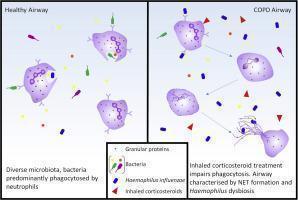
NET association with COPD. Dicker et al. Graphical Abstract. (http://www.jacionline.org/article/S0091-6749(17)30746-7/abstract)
Chronic Obstructive Pulmonary Disease (COPD) is an umbrella term used describe a group of lung diseases such as emphysema, chronic bronchitis, among others, and is primarily caused by cigarette smoking. Cigarette smoke has been observed to cause neutrophilic inflammation and impair anti-bacterial defences.
Neutrophils contribute to airway damage in COPD patients by releasing proteases and reactive oxygen species which can increase mucus production and mucocilliary dysfunction. As such, neutrophilic inflammation is a one of the major characteristics of COPD.
One of the anti-bacterial activities of neutrophils is neutrophil extracellular trap (NET) formation. NET is a process by which neutrophils release DNA (uncondensed chromatin and histones), neutrophil elastase and other granule products to trap bacteria. Recent data suggests that NET-associated neutrophil elastase is associated with COPD severity, however the patho-physiological relevance of NET has not been identified.
A collaboration between researchers from United Kingdom and Spain, aimed to determine correlations between NET release and disease severity, airway microbiome and neutrophil function. Researchers utilised sputum samples from COPD patients across a spectra of disease severity to measure NET concentrations. Since no gold standard for detection of NET activity in biological samples exists, Dicker et al. used 3 quantification methods: myeloperoxidase-DNA ELISA, sputum based detection of DNA-elastase and histone-elastase complexes.
NET concentration detected in sputum and not blood correlated with low levels of lung function, increased lung symptoms and exacerbation frequency, factors associated with increased COPD severity. Dicker et al. observed a negative correlation between NET levels and microbiome diversity, where higher NET concentrations were associated with low microbiome diversity dominated by Haemophilus sp, which represented greater than 40% of the microbiome diversity in some sputum samples. Studies have shown that Haemophilus influenza is potentially resistant to NET activity, this may explain increased proportions of Haemophilus sp in individuals with high NET activity.
This research highlights the potential use of NET as a biomarker for COPD as well as the need for further research determines the exact mechanisms by which NET causes microbiome dysbiosis.
Journal Article: Dicker et al. 2018. Neutrophil extracellular traps are associated with disease severity and microbiota diversity in patients with chronic obstructive pulmonary disease. The Journal of Allergy and Clinical Immunology.
Journal Article by Cheleka AM Mpande











